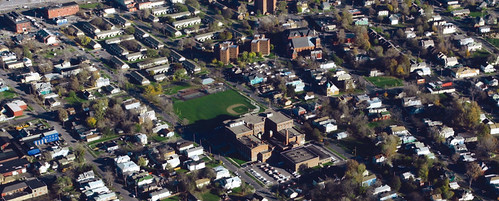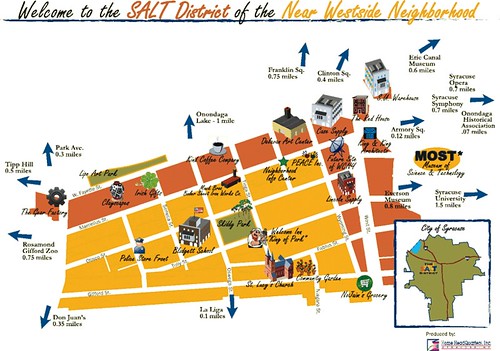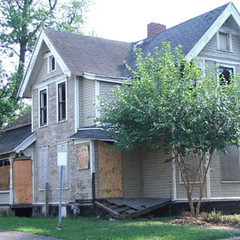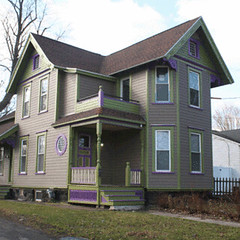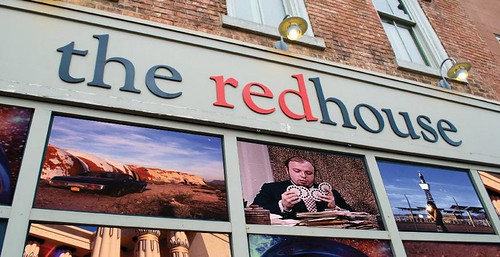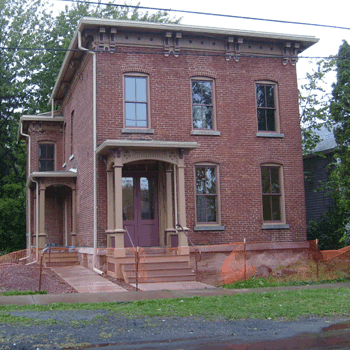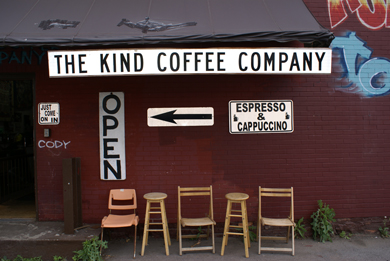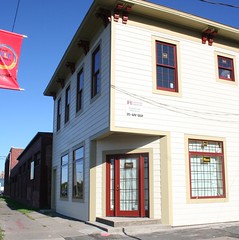Ambitious, revitalizing arts district goes green in Syracuse

Posted February 9, 2011 at 1:29PM
Take one part Paducah (arts-driven revitalization), one part Old North Saint Louis (incremental restoration of abandoned historic properties), mix in some serious winter weather, and you might just come out with something a lot like the Syracuse (NY) SALT District, an ambitious and fascinating arts-and-technology-driven revitalization effort.
According to the project’s web site, the initiative is aimed at nothing less than creating “a new epicenter of artistic and cultural development in the Syracuse and Central Upstate New York area.” It is being led by the Near West Side Initiative, Inc.
(Today’s post is co-authored with Aaron Welch, an urban planner with Raimi + Associates who helped guide the SALT District to green certification under LEED for Neighborhood Development. Aaron was kind enough to allow me to borrow from his article about the project for an update on LEED-ND, published last month by the US Green Building Council.)
A district for art and culture
The SALT District takes its name from an acronym of Syracuse, Art, Life, and Technology, or SALT. There is also historical association to the name, in that the neighborhood was once home to a salt works in Syracuse’s early industrial history, and Syracuse has been referred to as The Salt City since those early days. Reflecting that history, Salina Street runs through downtown Syracuse.
The SALT District (basically equivalent to the Near West Side) comprises older warehouses and commercial buildings along West Street and parts of West Fayette Street, on the edges of the neighborhood (see map). New warehouse-type spaces are also being developed along West Street, as part of the initiative. In addition, abandoned single-family houses and small properties suitable for mixed uses in the heart of the neighborhood are being rehabilitated and targeted for ownership and development by artists. All of these houses and new warehouse spaces have incentive programs available to lower the cost of ownership, increase community support and allow artists to participate in the value they are creating in the neighborhood.
The District is located directly west of Syracuse’s traditional downtown, within easy walking distance of the landmark Armory Square and the rest of downtown.
Among the program’s incentives are full exterior rehabs of vacant properties suitable for use as studios and live/work spaces, made available at affordable for-sale prices to buyers who commit to upgrading the interiors, remaining three years, and developing a business plan. Additional homes and properties are being made available as-is for a dollar (see before-and after photos of a dollar home, below). And there are also fully rehabbed properties available at attractive prices.
There is no doubt that the program has a critical mass of arts-related activity upon which to build. According to the web site, more than 60 artists are already working and living in warehouses with loft spaces and studios along West Fayette Street. The neighborhood also has become home to the pioneering Delavan Center (hosting several galleries), the Redhouse Arts Center (theater, film, music), Syracuse University’s Warehouse (with its School of Visual and Performing Arts and School of Architecture), Clayscapes Pottery and several other businesses.
Earning recognition as a green neighborhood
All this is laudable enough, but the SALT District also can now be called not just an artistic neighborhood but also a green one. Or, more specifically, green and gold, since the neighborhood has earned certification at the gold level pursuant to the LEED for Neighborhood Development rating system. While LEED-ND - like most green building rating systems - was designed to guide projects where the majority of square footage will be new construction and major renovations, the SALT District shows that the rating system also includes valuable sustainability metrics for existing neighborhoods.
In particular, the 156-acre district sits south of a once-burgeoning industrial port along the old Erie Canal. It has suffered from significant disinvestment over the last several decades, resulting in vacant properties, gaps and barriers in the street and walking network, and high rates of unemployment and poverty. Yet the SALT District remains a centrally located, historic neighborhood with a traditional neighborhood layout, already exhibiting many of the characteristics rewarded in the LEED-ND rating system: an in-town location that reduces driving trips and distances while allowing re-use of existing infrastructure; a mix of turn-of-the century housing and flexible commercial space; a school and community park at its center; well-connected and walkable streets; and proximity to a high number of jobs.
Taking advantage of these ready-made assets, a coalition of neighborhood partners - including residents and community groups, the Syracuse Center of Excellence, Home Headquarters affordable housing development, the School of Architecture at Syracuse University, and the City of Syracuse - have created a plan for the SALT District that successfully earned LEED-ND certification. The plan features extensive reuse and rehabilitation of existing buildings, energy and water efficiency retrofits in existing buildings, redevelopment in targeted locations, and green building requirements for new construction.
It also includes several new streets and pedestrian facilities to connect better to surrounding areas, improved transit service and facilities, multiple new parks, enhanced stormwater management, and protection of the neighborhood's creek and floodplain. The neighborhood will continue to feature a diversity of housing types and affordability levels, enabling a wide array of people to call it home.
That’s a lot, no? According to the website of the Center of Excellence, the Near Westside Initiative is specifically intended “to decrease energy use in homes and increase indoor air quality; help find environmentally-friendly solutions to storm water management; promote deconstruction practices; and create green collar jobs.” (Read more about the district’s green aspirations here.)
"We believe we've created a blueprint for the SALT District's future while advancing the practice of sustainability and neighborhood planning at a national level," says Ed Bogucz, Executive Director of the Syracuse Center of Excellence and one of the early champions of the project.
The work of the Near Westside Initiative in restoring the neighborhood has been recognized as a human achievement as well as an artistic and environmental one. In 2010 the project received the 2010 InterFaith Leadership Award from InterFaith Works of Central New York. Beth Broadway, Interfaith’s executive director, had this to say to the Initiative’s leaders:
“With leadership, dedication and love, you are working to strengthen neighborhoods and create a new community spirit that embraces diversity, celebrates the promise that exists in each of us and promotes positive change in ourselves and in the places we live and work together. Through your friendship and partnership, you are helping our neighbors in Central New York see what is possible and encouraging them to work toward achieving their dreams. Your work and the work of the Near Westside Initiative are building a community where residents are empowered and where each individual’s dignity and respect is strengthened by the warmth and affection of their neighbors.”
(Now would be an appropriate time for applause.)
LEED-ND process and team
The SALT District project provides a replicable model for using LEED-ND to guide investment in existing neighborhoods across the country. In a post two weeks ago, we outlined the basic steps for using the system to green an older neighborhood:
- Assess the neighborhood. Audit the neighborhood using the LEED-ND prerequisites and credits. This can range from a quick audit performed in an afternoon to an in-depth evaluation, depending on your needs.
- Focus on strengths and weaknesses. Identify areas where the neighborhood performs well under LEED-ND and where it does not.
- Respond with a plan. Propose retrofits, targeted redevelopment, infrastructure improvements, or policies for the future that build on the neighborhood's strengths and address its weaknesses. The level of detail and effort can vary widely - from an informal list of suggestions to a detailed design and policy proposal that becomes the backbone of a neighborhood plan.
That’s exactly what was done here, with very promising results.
The SALT District LEED for Neighborhood Development project was managed by Raimi + Associates of Berkeley, CA. The design phase of the project involved a design charrette that included Opticos Design of Berkeley, CA; Jessica Millman from the Agora Group, of Skaneateles, NY; and Northeast Green Building Consulting, of Syracuse, NY.
A video treat
Finally, we leave you with an engaging and fun video featuring some of the artists who are making the SALT District such a great story to tell:
Move your cursor over the images for credit information.
Aaron Welch, LEED AP, is a senior planner at Raimi + Associates, in Berkeley, CA. He was the project manager for the SALT District LEED-ND project and has helped numerous other projects pursue LEED-ND certification. He also wrote portions of USGBC's LEED for Neighborhood Development Reference Guide, and is working with NRDC to create A Citizen's Guide to LEED for Neighborhood Development.
